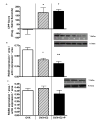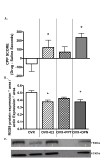Evidence for the involvement of ERbeta and RGS9-2 in 17-beta estradiol enhancement of amphetamine-induced place preference behavior
- PMID: 17493623
- PMCID: PMC2096711
- DOI: 10.1016/j.yhbeh.2007.03.017
Evidence for the involvement of ERbeta and RGS9-2 in 17-beta estradiol enhancement of amphetamine-induced place preference behavior
Abstract
Estrogen enhances dopamine-mediated behaviors, which make women and female rats more sensitive to the effects of the psychostimulant drugs, cocaine and amphetamine. How cocaine and amphetamine elicit more robust behavioral responses in females remains unclear, but studies have shown that the Regulator of G-protein Signaling 9-2 (RGS9-2) protein is an important modulator of the behavioral responses to these drugs. Previously, we reported that 17-beta estradiol reduced RGS9-2 mRNA expression in the shell of the nucleus accumbens, but not the core. The present studies were designed to further evaluate the involvement of RGS9-2 in estradiol enhancement of amphetamine-induced place preference behavior and to examine which estrogen receptor subtype mediates the effect of estradiol. Female Sprague-Dawley rats were ovariectomized and treated for 14 days with an inert vehicle or 17-beta estradiol (by Silastic implant or injection [80 microg/kg]). 17-beta-Estradiol-treated female rats had enhanced amphetamine-induced conditioned place preference behavior compared to vehicle-treated, ovariectomized female rats. In situ hybridization histochemistry and Western blotting identified an inverse relationship between RGS9-2 protein expression in the nucleus accumbens shell and the hormonal enhancement of amphetamine-induced place preference behavior. A similar relationship was not found between place preference behavior and RGS9-2 expression in the accumbens core. Moreover, treatment of ovariectomized female rats with the selective estrogen receptor-beta agonist, diarylpropionitrile (1 mg/kg), for 2 weeks also facilitated amphetamine-induced place preference behavior and selectively reduced nucleus accumbens shell RGS9-2 protein expression. These data provide insight into a potential mechanism by which estrogen and/or sex modulate mesoaccumbal dopamine receptor signaling and possibly, addictive behaviors.
Figures



Comment in
-
Sex and drugs: comment on "Evidence for involvement of erbeta and rgs9-2 in 17-beta estradiol enhancement of amphetamine-induced place preference behavior" by Silverman and Koenig.Horm Behav. 2007 Aug;52(2):143-5. doi: 10.1016/j.yhbeh.2007.05.003. Epub 2007 May 10. Horm Behav. 2007. PMID: 17553500 Free PMC article. No abstract available.
References
-
- Aragona BJ, Liu Y, Yu YJ, Curtis JT, Detwiler JM, Insel TR, Wang Z. Nucleus accumbens dopamine differentially mediates the formation and maintenance of monogamous pair bonds. Nat Neurosci. 2006;9:133–139. - PubMed
-
- Becker JB. Gender differences in dopaminergic function in striatum and nucleus accumbens. Pharmacol Biochem Behav. 1999;64:803–812. - PubMed
-
- Becker JB, Rudick CN. Rapid effects of estrogen or progesterone on the amphetamine-induced increase in striatal dopamine are enhanced by estrogen priming: a microdialysis study. Pharmacol Biochem Behav. 1999;64:53–57. - PubMed
-
- Becker JB, Beer ME, Robinson TE. Striatal dopamine release stimulated by amphetamine or potassium: influence of ovarian hormones and the light-dark cycle. Brain Res. 1984;311:157–160. - PubMed
-
- Becker JB, Molenda H, Hummer DL. Gender differences in the behavioral responses to cocaine and amphetamine. Implications for mechanisms mediating gender differences in drug abuse. Ann N Y Acad Sci. 2001;937:172–187. - PubMed
Publication types
MeSH terms
Substances
Grants and funding
LinkOut - more resources
Full Text Sources

